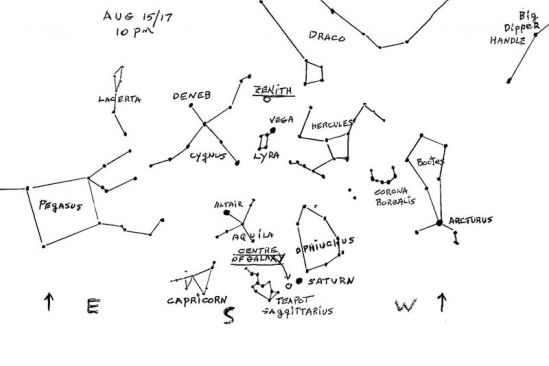Fred Barrett | Aug 02, 2017
The big news this month is that a partial eclipse of the Sun will occur in our area on August 21 starting about 1 pm. Our American friends can view the Total Eclipse along a path that curves across the middle of the United States. If you are ambitious enough and want to see the total eclipse in person, you will have to travel to the American south on a line through Kentucky to South Carolina. It’s an experience like no other and well worth the effort. In our area, we will have the shadow of the Moon cover about 60 to 70 percent of the Sun. Looking directly at the Sun to view the partial eclipse is a bad, bad idea. Welders goggles rated 12 or higher must be used and special eclipse glasses are available for sale at various places. DON’T use sunglasses. Eclipse appropriate eye protection is typically 100,000 times darker than sunglasses. Carefully inspect your eye protection for scratches or other damage. Alternately, an inexpensive way to view a partial eclipse is to punch a small hole in a thin piece of cardboard and place a sheet of flat, white paper about a foot beneath it. It will have an image of the partially shadowed Sun projected on it. Go out on a sunny day and practice. Try different distances between the pinhole and the sheet of paper. Vary the hole size too, from tiny to not so tiny.
I’m sorry about last month’s picture. Unfortunately, trying to show a few small, white dots on a mostly black picture printed on newsprint quality paper, is very difficult. In future, I will use illustrations where the picture or drawing is a negative version of real life. That is, black space will be white and stars will be black. This will help avoid last month’s problem. Actually, professional star charts are published in exactly this way for the same reasons that caused my error last month. You use an awful lot less black ink too. Of course, I will experiment with other methods of providing you with a useful visual aid but in doing so I’ll stick with the old KISS principle – Keep It Simple Stupid!
Use this month’s illustration to see if you can find some of the constellations. With you facing south, hold the illustration in front of you. If it’s hard to see, try using a flashlight with the lens covered with red tinted paper or plastic. White light will ruin your night vision but red light helps preserve it. The zenith, or straight overhead in the sky, is near the bright star Vega. Find Vega first, then work your way east to Deneb and then down to Altair. Now that you’re oriented, try figuring out the shapes of the constellations. The Milky Way, our galaxy, wends its way down through Cygnus, Aquila and passes through the asterism called The Teapot in the constellation Sagittarius. The centre of our galaxy is just above the spout of the teapot. At midmonth at 10pm, Saturn will be near the teapot’s spout.
The always anticipated Perseid meteor shower is active this month and peaks on the morning of August 12. Although a high of some 150 meteors is expected, the backlight of a bright gibbous waning Moon interferes with seeing a lot of those meteors. Still, it’s certainly worth going out on a warm summer evening during the week before and after the peak to watch the show.
In the evening sky Mercury and Jupiter are in the west and Saturn in the south. Saturn moves to the southwest by midnight. In the morning, Venus comes up about 2 ½ hours before the Sun and is bright and 20 degrees high just before dawn.
August 3: The Moon is 3 degrees north of Saturn at 3 am.
August 7: This month’s full moon is called the Full Sturgeon Moon. Sturgeon in the Great Lakes and nearby waters can be more easily caught during this month. August can be a dusty month and since dust in the air filters out all but the colour red, Full Red Moon is another name.
August 14: Get your telescope out and look for seven of Saturn’s moons near this beautiful ringed planet.
August 18: The Moon is at perigee (363,995 Kilometers).
August 19: The Moon is just south of Venus around 1 in the morning.
August 21: Partial solar eclipse. 60 to 70% coverage of the Sun.
August 30: The Moon is at apogee (401,962 Kilometers).
Keep looking up!
“The Beginners Observing Guide” by Leo Enright is an invaluable companion for adventures in the night sky. It contains star charts and is packed with information. It can be purchased at the Sharbot Lake pharmacy or it can be ordered from the Royal Astronomical Society of Canada at www.rasc.ca/publications. A subscription to our very own excellent Canadian astronomy magazine “SkyNews”, with its centerfold sky chart, can be ordered at the RASC site as well.
Email me at This email address is being protected from spambots. You need JavaScript enabled to view it. to ask questions or report any unusual sights in the night sky.
Clear Skies! Fred
More Stories
- The Sun Shines On The Parham Fair
- Creating Your Own Weather, Forever and Ever
- Silver Lake Pow Wow Set For A Big Year
- South Frontenac Receives Substantial Provincial Grant for their Verona Housing Project
- South Frontenac Council Report - August 12
- Dumping To Be Curtailed At Loughborough Waste Site
- Central Frontenac Inching Towards Increasing Severance Opportunities
- Addington Highlands Council Report - August 12
- Addington Highlands Council Report - August 5
- Addington Highlands Council Report - August 12

